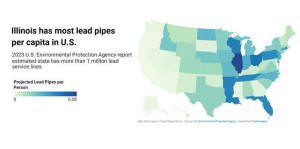As state continues to inventory lead pipes, full replacement deadlines
are decades away
 Send a link to a friend
Send a link to a friend
[April 13, 2024]
By COLE LONGCOR
Capitol News Illinois
Clongcor@capitolnewsillinois.com
 Lead pipes in public water systems and drinking fixtures have been
banned in new construction since 1986, when Congress amended the Safe
Drinking Water Act, but they are still in use across the U.S. and in
Illinois. Lead pipes in public water systems and drinking fixtures have been
banned in new construction since 1986, when Congress amended the Safe
Drinking Water Act, but they are still in use across the U.S. and in
Illinois.
The presence of lead pipes has persisted due in part to a lack of a
centralized federal or state removal strategy, as well as inadequate
funding and insufficient inventories of where lead pipes are located.
In Illinois – which has the most lead pipes per capita of any state,
according to a 2023 study by the U.S. Environmental Protection Agency –
water suppliers are in the process of inventorying their lead pipes to
get a clearer picture of timelines for removal over the next several
decades.
The health impacts of lead exposure are widely known. According to the
U.S. Centers for Disease Control and Prevention, there is no safe level
of lead exposure for children. While not technically enforceable, the
U.S. EPA’s goal for maximum contaminant level of lead is zero.
Still, replacement efforts are slow, with environmental advocates,
lawmakers and others citing lack of funding as a key barrier to
progress.
“One of the most urgent issues that we all could be facing in Illinois
right now is removing lead from our lead pipes throughout the state,
both residential, commercial and public pipeways,” Sen. Mike Simmons,
D-Chicago, said at a news conference last month. “I think it's been
pretty well documented that there's a significant cost that will come
with really doing justice to the task.”

This fiscal year, Illinois received over $100 million in funding through
the federal Bipartisan Infrastructure Law for lead service line
replacement, and funding is expected to more than double in fiscal year
2025.
In 2021 the National Resources Defense Council estimated there to be
679,292 lead service lines in Illinois. In 2023, the U.S. EPA put the
estimate at over one million lines in Illinois.
The NRDC puts the estimate for replacing every lead service line in
Illinois at $2.2 billion, while the Illinois Environmental Council
estimates it would cost between $10 billion and $12 billion.
Even as some funding has become available through that law and the
federal Drinking Water State Revolving Fund, the allocations are not
nearly enough to replace every service line in the state, regardless of
who is estimating the cost.
While replacement is ongoing, a full inventory is crucial to develop a
plan and budget for the complete removal of lead service lines in the
state.
The IEPA is in the process of building a more conclusive inventory of
lead service lines, requiring the state’s community water supplies to
submit full inventories of their pipes by April 15. Even with accurate
quantities, establishing adequate funding and feasible timelines is a
struggle.
Replacement efforts in Illinois
While the state and federal governments have created regulations and
funding programs, the responsibility of lead service line replacement
falls on the community water supplies, such as municipalities or local
water districts.
The state has been funding community water supplies’ replacement
projects for years, although not at the multi-billion-dollar level
needed to replace all lines. The IEPA provided funding through principal
forgiveness loans from 2017 to 2023 under the wastewater category of the
State Revolving Fund. IEPA awarded over $120 million in principal
forgiveness funds during those six years and each applicant was eligible
for a maximum award of $4 million annually.
Under the federal Bipartisan Infrastructure Law, states are required to
allocate 49 percent of state lead service line replacement funds as
grants or principal forgiveness loans and 51 percent as traditional
low-interest loans. IEPA spokesperson Kim Biggs said that in fiscal year
2024, there is a cap of about $2.8 million per principal forgiveness
loan recipient.
“But we're trying to figure out how we can get more and more from the
federal government,” Iyana Simba, Illinois Environmental Council city
programs director, said. “We need this funding to make sure that the
cost of lead service line replacement isn't passed down to individual
homeowners, and that it's also being done so in a more equitable
manner.”
Aside from increasing funding, Simba said that developing community
outreach, technical assistance and community planning could hasten
replacement efforts.
The Illinois Lead Service Line Replacement and Notification Act took
effect on Jan.1, 2022. The law requires community water supplies to
create an inventory and replacement plan for their lead service lines.
The report must be submitted to the IEPA by April 15. Yearly updates on
replacement will be due every April 15 through 2027.
[to top of second column]
|

A 2023 U.S. Environmental Protection Agency report estimated
Illinois has the most lead service lines per capita in the country.
(Capitol News Illinois graphic by Cole Longcor)

“So even while Illinois has about 600,000 lead pipes throughout the
state that are accounted for,” Simba said. “I’m really hoping that
through this inventory process we'll get a better picture because
there's almost that same amount of service lines that are made of
unknown material.”
The IEPA created the Lead Service Line Inventory Grant program to
provide funding to community water supplies to identify and inventory
lead service lines. The first round of funding was announced in January
2023, since then two more rounds have been awarded and the IEPA is
currently accepting applications for the fourth round. The grant
provided 260 community water supplies between $20,000 and $50,000 each
in 2023.
The current FY24 project list from the IEPA includes 47 projects,
totaling over $100 million. Illinois received around $107 million in
FY24 and will receive $230 million in FY25 from federal funding.
Gov. JB Pritzker’s proposed FY25 budget would allocate $20 million to
lead service line replacement planning grants. The capital
infrastructure budget proposal also includes around $340 million in
reappropriated funding along with almost $260 million in new
appropriation for Lead Service Line Replacement loans.
Timelines for replacement
While the inventory reports must be submitted to the IEPA by April 15,
it is not clear when line replacements will be completed, and state law
lays out a decadeslong process.
The U.S. EPA has proposed changes to federal rules which would set the
goal of replacing all lead pipes within 10 years, with certain
exceptions allowed. The proposal follows decades of amending policies to
tighten regulations on maximum contaminant levels. The most recent
changes, however, have not been adopted, and the U.S. EPA has
historically chosen not to strictly enforce its existing standards.
Advocacy groups, including the Illinois Environmental Council, support
the shortening of timelines for replacement.
“So while we’re happy to see that other smaller communities are going to
be put on this 10-year timeline. That’s even more stringent than some of
the things outlined in the state bill,” Simba said. “We do need to see a
shorter timeline for Chicago.”
Illinois’ Lead Service Line Replacement and Notification Act also
establishes timelines for replacement based on the number of lead
service lines within a community starting in 2027. Community water
supplies with fewer than 1,200 lines have the shortest deadline of 2042,
while supplies like Chicago, with more than 99,999 lines have until
2077.
Community water supplies can request extensions up to 20 percent of
their timeframe, so Chicago could potentially have an additional 10
years, extending the deadline to 2087.
In February, state Rep. Anthony DeLuca, D-Chicago Heights, filed House
Bill 4752, which would increase the maximum timeline extension the IEPA
is allowed to grant community water supplies from 20 to 30 percent. If
passed, the extension increase would mean Chicago could have up to 2092
to replace all their lead service lines.

DeLuca said municipalities do not have enough funding and a timeline
extension is needed to make up for the lack of resources.
Advocates, meanwhile, have pointed to health care and economic
incentives for replacing lead pipes. An October report from the NRDC,
dubbed “Getting the Lead Out,” found removing lead pipes can reduce the
risk of medical conditions in children, such as hearing impairments,
short-term cognitive damage and behavioral problems. It would also help
adults by reducing immunological and red blood cell damage.
The study found between $58 and $89 billion will be spent in Illinois
over a 35-year period related to health effects of lead pipes, and
removing them would save about $37 billion annually in health care costs
nationwide.
Simmons said lawmakers need to work to secure more funding and stricter
timelines.
“I mean, there's not a lot of room to waffle on this,” Simmons said.
“Already, our communities have waited decades to have access to safe
drinking water and that includes zero lead pipes.”
Capitol News Illinois is
a nonprofit, nonpartisan news service covering state government. It is
distributed to hundreds of print and broadcast outlets statewide. It is
funded primarily by the Illinois Press Foundation and the Robert R.
McCormick Foundation, along with major contributions from the Illinois
Broadcasters Foundation and Southern Illinois Editorial Association. |